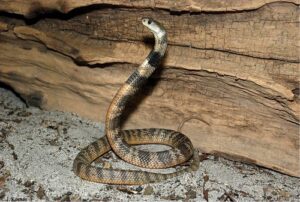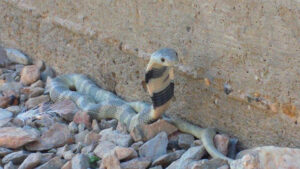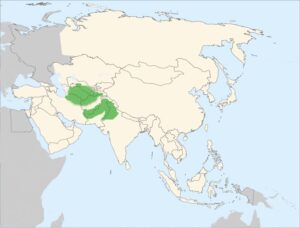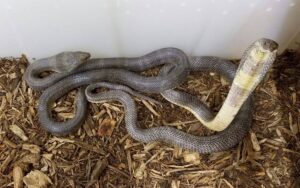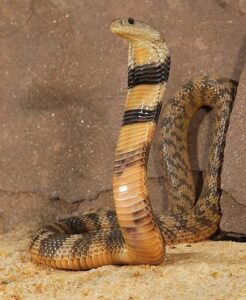The Caspian cobra is the westernmost Asian venomous snake species. They are also known as Central Asian cobras, ladle cobras, Oxus cobras, or Russian cobras. In 1831, the Caspian cobra was initially described as Tomyris oxiana by Baltic German naturalist Karl Eichwald; later on, it was placed under the genus Naja by Russian naturalist Alexander Strauch. Their genus name ‘naja‘ derives from the Latinized Sanskrit word nāgá meaning “Snake”. And the species epithet ‘oxiana‘ derives from the Greek word Ôxos or the Latin word Ōxus, both referring to the ancient name of the Amu Darya River that flows along the northern border of Afghanistan.
Scientific Classifications
- Suborder:Serpentes
- Family:Elapidae
- Genus:Naja
- Species:N. oxiana
Conservation Status
Description
Size
The average length of the Caspian cobra is 3-5 ft (1-1.5 m), though it is rare some specimens might reach over 5.6 ft (1.7 m)
Color and Appearance
These are medium-sized snakes with heavy bodies, elliptical and depressed heads, and slightly distinct necks with long cervical ribs that can expand to form hoods. Unlike the oval-shaped hoods of some other species in its genus, the Caspian cobra’s hood is more elongated and gradually narrows down to blend with the rest of the body. They also have short, round snouts with large nostrils and medium-sized eyes with round pupils. The anterior part of their bodies is depressed on both the dorsal and ventral sides, and the posterior part is sub-cylindrical.
Their scales are arranged in 23 – 27 smooth and strongly obliqued dorsal scale rows at the hood and 19-23 a little ahead of the midbody; two or three rows on the outer side are more significant than the rest. The number of their ventral scale is 191-210, and subcaudal scales are 57-71, with all of them paired. Cuneate scales are mostly absent.
The coloration of their bodies ranges from light to dark brown to yellow. Juveniles are pale with dark and light bands around their body. Adults do not generally have these bands, although, in some specimens, the traces of these banding remains even after growing into full adults.
Are they Dangerous
These are one of the world’s most venomous snakes. The Caspian cobra is one of the ‘true cobras’ incapable of spitting venom, the other being the Indian cobra. They inject about 75-125 mg of venom per bite; however, they may yield more than 700 mg in some bites, higher than the black mamba and the inland taipan.
Their venom has an LD50 value of 0.21 – 0.4 mg/kg. It contains cardiotoxins, cytotoxins, and short neurotoxins that cause ataxia, drowsiness, hypotension, paralysis of the throat and limbs, and weakness. These symptoms may start appearing within 15 minutes of being bitten.
Like most cobras, these snakes avoid humans and prefer to be left alone. However, when disturbed, both adults and juveniles are incredibly aggressive, with juveniles sometimes being more aggressive than adults, which makes the Caspian cobra responsible for several fatalities in their region.
Caspian Cobra At a Glance
Distribution
Their range includes eastern Afghanistan; parts of India include Himachal Pradesh, Punjab, and Ladakh in Jammu and Kashmir. They occupy the southern part of Ardabil Province, East Azerbaijan Province, the eastern part of Isfahan Province, the northeastern region of Kerman Province, northern Sistan and Baluchistan Province, Tehran Province, the east part of Yazd Province, the Zanjan Province, and the Provinces of Semnan, Mazandaran, and Golestan and the entire North, South, and Razavi Khorasan in Iran. These cobras also range across Fergana Valley in Kyrgyzstan, the Kashmir region in northern Pakistan, southwestern Tajikistan, Turkmenistan, and Uzbekistan.
Evidence of some population living in Kazakhstan was found when a biochemical engineer Brian Hayes, led an expedition with the United States Threat Reduction Agency to Vozrozhdeniye island, which is split with a border between Kazakhstan and Uzbekistan. He and his team encountered an eight feet long cobra and shot it. Since Caspian cobras are the only cobra to occur in that region, it is possible that this snake was one of them.
Habitat
They are diurnal and highly solitary, inhabiting arid and semiarid rocky foothills and tropical and temperate shrublands and sometimes taking shelter in tree hollows or embankment holes.
These snakes hibernate in cracks, deep gerbil burrows, and even under residential buildings.
Lifespan
The Central Asian cobra has an average lifespan of 20 years in the wild.
Predators
Natural enemies of these cobras include large birds of prey like snake eagles and several species of mongoose, and occasionally other snake species. Juveniles are more likely to be targeted than adults.
If cornered or threatened, these agile snakes take a defensive stance by spreading their hoods and hissing, then swaying from side to side, they strike multiple times.
Diet
Their primary diet consists of small birds, frogs, rodents, toads, and occasionally, fish, birds’ eggs, and even other snakes. They will also climb trees and spend a lot of time swimming and foraging in water.
Reproduction
The mating season takes place in May, with females laying 6-19 one-two inches eggs in termite mounds or rat holes around July. These eggs are fiercely guarded, and after 60-65 days of incubation, hatchlings measuring 1-1.5 inches appears.
Juveniles become sexually mature at 3-4 years old.
Similar Species
Indian Cobra
For a long time, the Caspian cobra was considered a subspecies of the Indian cobra; however, after genetic analysis, it was revealed to be a separate species. These two snakes can be confused with each other since they have the same distribution across northern India and Pakistan.
FAQs
Ans: Despite being primarily diurnal, these snakes display crepuscular or nocturnal behavior during hot months like July and August.
Ans: The Caspian cobras are threatened by many factors such as habitat loss caused due to overgrazing, agricultural development etc. As well as overhunting of this species serve as a major threat to them.
Source
i.pinimg.com, fbcdn.net, citizendium.org, tumblr.com, flickr.com, zooinstitutes.com, inaturalist.org


